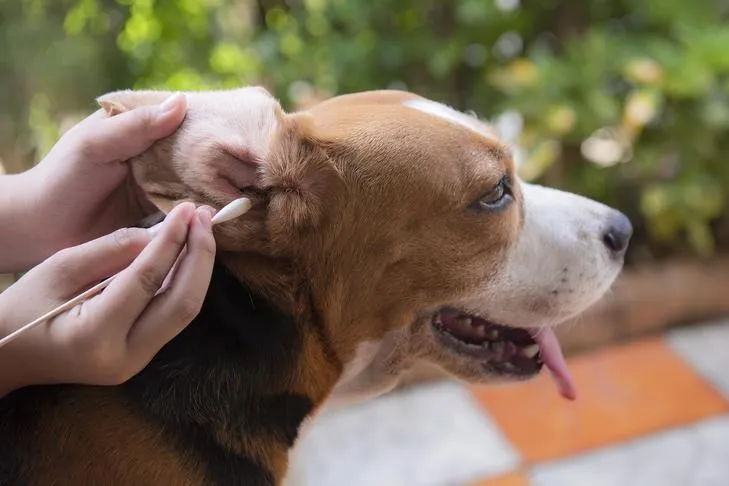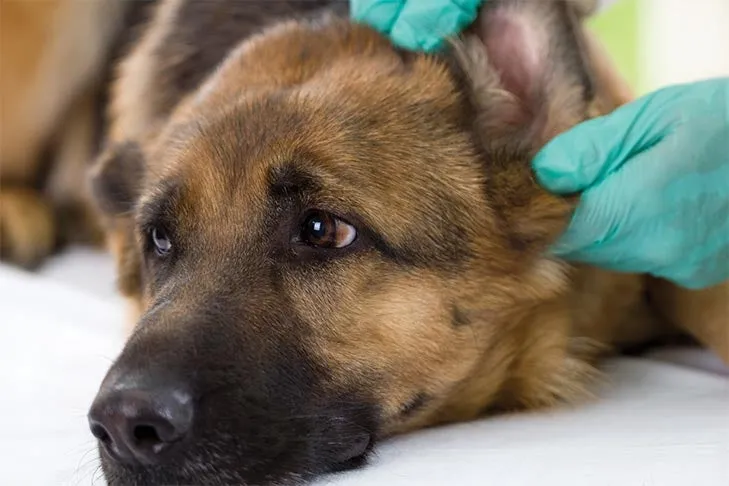As devoted dog owners, we recognize that consistent ear care is a fundamental component of our canine companions’ overall well-being. However, maintaining clean and healthy ears can present a challenge, especially if your dog isn’t accustomed to regular handling or if you’re uncertain about the correct cleaning techniques. Effective Ear Care For Dogs extends beyond simple cleaning; it involves understanding ear health, recognizing potential problems, and preventing discomfort or serious conditions.
This comprehensive guide aims to equip you with the knowledge and practical tips necessary to keep your dog’s ears clean, comfortable, and healthy, ensuring they live their happiest lives. By following these expert recommendations, you can proactively safeguard your furry friend from common ear ailments and contribute significantly to their long-term health. Regularly checking and cleaning your dog’s ears can prevent complications and allow for early detection of issues, which is crucial for prompt treatment. If you ever have concerns about your dog’s health, seeking advice from an animal care veterinary hospital is always a wise first step.
Understanding Your Dog’s Ears: Anatomy and Vulnerability
A dog’s ear canal is distinct from a human’s, featuring a unique L-shaped structure that makes it more prone to trapping moisture, debris, and wax. This anatomical design, while protective in some ways, also creates an ideal environment for bacteria and yeast to thrive, particularly in warm, moist conditions. Several factors can increase a dog’s susceptibility to ear problems:
- Ear Flap Type: Breeds with long, floppy ears, such as Basset Hounds and Cocker Spaniels, have reduced airflow to the ear canal, trapping humidity and increasing the risk of infection.
- Water Exposure: Dogs that frequently swim or get wet during baths are more susceptible to moisture accumulation in their ears, leading to swimmer’s ear.
- Allergies: Environmental or food allergies can manifest as ear inflammation and itching, making dogs more prone to secondary infections.
- Excessive Hair: Some breeds have hair growing inside their ear canals, which can trap debris and reduce ventilation.
Regular attention to these factors is a cornerstone of effective ear care for dogs.
How Often Should You Clean Your Dog’s Ears?
The frequency of ear cleaning varies significantly among dogs. Some fortunate canines naturally maintain healthy, clean ears and may rarely require intervention. Others, however, necessitate regular cleaning to prevent the accumulation of dirt, wax, and debris that can pave the way for painful ear infections. Breeds with long, pendulous ears, like Basset Hounds and Cocker Spaniels, face a higher predisposition to ear infections due to poor air circulation. However, it’s crucial to remember that all breeds and individual dogs can develop ear issues.
Dogs prone to ear infections or those who spend considerable time in water may require more frequent cleanings. For dogs that swim regularly, using topical astringents can help dry their ear canals and ensure proper ventilation, reducing moisture buildup. It’s equally important to prevent water from entering your dog’s ear canals during bath time.
Making the examination of your dog’s ears a regular part of their basic grooming routine is highly recommended. Your dog might enjoy a gentle ear rub when their ears are healthy, but if they recoil or show sensitivity, it could indicate soreness or an underlying issue. A quick, gentle check daily allows you to monitor their condition and catch any problems early.
Recognizing Signs Your Dog’s Ears Need Attention
Before reaching for the ear cleaner, it’s vital to assess whether your dog’s ears actually require cleaning. Over-cleaning can lead to irritation and even infection, counteracting your good intentions. Familiarize yourself with the characteristics of a healthy, clean ear: it should appear pink, be free of odor, and show no signs of dirt, redness, or inflammation. A healthy ear typically has no strong scent – certainly not a yeasty or foul odor. Only proceed with cleaning when you observe a noticeable change from this healthy baseline.
If you detect a mild odor or notice your dog shaking their head more frequently than usual, it’s likely time for an ear cleaning. However, if your dog’s ear appears red and inflamed, emits a strong yeasty smell, or they exhibit signs of pain, it’s imperative to consult your veterinarian immediately. These symptoms could point to a serious condition such as an ear infection, the presence of fleas or ear mites, or even allergies, all of which demand professional medical attention. Prompt veterinary care is essential to accurately diagnose and manage these conditions, as attempting to clean an already infected ear can often worsen the situation. For guidance on addressing such issues, learning how to heal a dogs ear infection is critical and often requires veterinary prescribed medication.
 A gentle beagle receives an ear cleaning from its owner, highlighting routine ear care for dogs.
A gentle beagle receives an ear cleaning from its owner, highlighting routine ear care for dogs.
Essential Supplies for Safe Dog Ear Care
You only need a few key supplies to effectively and safely clean your dog’s ears. Gather a cotton ball or gauze, a veterinary-approved dog ear-cleaning solution, and a clean, dry towel. It is critically important to avoid using cotton-tipped swabs (Q-tips) or any tool with a pointed tip. These can inadvertently push dirt and debris deeper into the ear canal, potentially causing infections or even traumatic injury to the delicate inner structures of the ear.
Why Veterinary-Formulated Cleaners Are Best
While the internet abounds with recipes for homemade ear-cleaning solutions, veterinary-formulated dog ear cleaners are undeniably the safest and most effective choice. Many DIY solutions contain ingredients that can be harmful or irritating to your dog’s sensitive ear tissue, while others simply lack the efficacy to properly clean and prevent issues. For instance, never use hydrogen peroxide on your dog’s ears. This common household product can cause significant irritation to healthy skin cells. Given the highly sensitive nature of ear tissue, prolonged use of hydrogen peroxide can lead to damage to the ear canal itself. Always stick to products specifically formulated for canine ears by veterinary professionals.
Most reputable veterinary offices stock a range of ear cleaners for dogs. Your veterinarian can offer personalized recommendations based on your dog’s specific breed, ear anatomy, and any existing sensitivities or medical history. Consulting experts, such as those at a companion care vets facility, ensures you select the most beneficial product for your pet’s unique needs. Reputable clinics like animal medical center of middletown can also provide tailored advice on ear hygiene.
 A close-up of a bulldog's ear, illustrating sensitive skin and the importance of gentle, specialized ear care products for dogs.
A close-up of a bulldog's ear, illustrating sensitive skin and the importance of gentle, specialized ear care products for dogs.
Step-by-Step Guide to Cleaning Your Dog’s Ears
Ear cleaning, though straightforward, can be a bit messy. Consider performing this task in a bathroom or a room that is easy to clean, just in case your dog shakes their head vigorously during the process, which is a very common reaction.
- Preparation and Application: Begin by assembling all your supplies within easy reach. Choose a time when your dog is calm and relaxed, as this will significantly ease the process. Don’t hesitate to use treats to create a positive association with ear cleaning, making it a more pleasant experience for your pet. Gently squeeze a veterinary ear-cleaning solution into your dog’s ear canal until it is visibly filled. After application, softly massage the base of the ear for approximately 30 seconds. You should hear a squishing sound as the solution begins to dislodge and dissolve any trapped debris and wax. Be careful to prevent the tip of the applicator bottle from touching your dog’s ear to avoid contaminating the solution with bacteria.
- The Shake-Off: Allow your dog to shake their head naturally. This action helps to move the loosened debris out of the ear canal. This is where your towel becomes indispensable – use it to shield yourself from any spray and to wipe down your dog’s face if the solution drips out of their ears.
- Gentle Wiping: Once your dog has finished shaking, take a clean cotton ball or piece of gauze and gently wipe out the accessible part of the ear canal. Ensure you do not insert your finger or any object deeper than the length of your first knuckle into the ear. If, at any point during the cleaning process, your dog appears to be in pain, stop immediately and consult your veterinarian. Pain could indicate an underlying infection or injury that requires professional medical assessment.
Common Mistakes to Avoid in Dog Ear Care
Even a seemingly simple task like cleaning your dog’s ears can be prone to common errors. Steering clear of these pitfalls will significantly contribute to keeping your dog’s ears clean, healthy, and free from complications:
- Not Using Enough Ear Cleaner: Many owners underestimate the amount of solution needed. You might think a few drops are sufficient, but for the product to be fully effective, you need more. When pouring the solution into your dog’s ear, continue until you can see the liquid pooling at the opening of the ear canal. This ensures the solution can adequately reach and dislodge debris within the L-shaped canal.
- Cleaning Potentially Infected Ears: If your dog’s ears show signs of inflammation, redness, or have an unpleasant odor, your first instinct might be to clean them to alleviate discomfort. However, attempting to clean an already infected ear often causes more harm than good, pushing bacteria deeper or irritating inflamed tissues further. If you suspect your dog has an ear infection, the most responsible action is to take them to their veterinarian. A professional can accurately diagnose the condition and prescribe the appropriate treatment, which may include antibiotics or antifungal medications.
- Over-cleaning Your Dog’s Ears: There is indeed such a thing as excessive cleaning when it comes to your dog’s ears. Cleaning them too frequently can strip the natural protective oils, leading to dryness, irritation of the delicate skin, or even secondary complications. Always follow your veterinarian’s recommendations regarding cleaning frequency. If you have any questions about your dog’s specific ear care requirements or concerns about finding proper veterinary assistance, consulting vets for guinea pigs near me can provide a starting point for finding local veterinary services, adaptable for dog owners as well.
 A veterinarian carefully examines a German Shepherd's ear, emphasizing professional check-ups as part of comprehensive ear care for dogs.
A veterinarian carefully examines a German Shepherd's ear, emphasizing professional check-ups as part of comprehensive ear care for dogs.
Taking proactive steps in your dog’s ear care regimen is paramount to preventing painful ear infections and maintaining overall ear health. Regular examinations, whether performed by you at home or by a veterinarian, not only catch developing problems such as ear mites or minor infections before they escalate but also help acclimate your dog to having their ears handled. With patience, consistent care, and the right approach, your dog can learn to tolerate – and perhaps even enjoy – their ear cleaning routine, ensuring their ears remain a source of comfort, not concern.
References
- American Kennel Club. (n.d.). Dog Ear Infections: Symptoms, Treatment, and Prevention. Retrieved from https://www.akc.org/expert-advice/health/dog-ear-infections/
- American Kennel Club. (n.d.). How to Groom a Dog: Brushing, Bathing, and More. Retrieved from https://www.akc.org/expert-advice/health/how-to-groom-a-dog/
